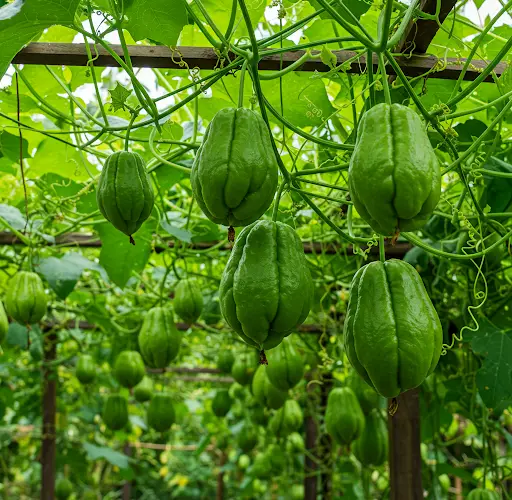Chayote, also known as vegetable pear or mirliton, is a versatile and fast-growing vegetable that’s popular in many cuisines around the world. With its mild flavor and crisp texture, chayote is ideal for stir-fries, soups, and salads. While it might seem like a crop best suited for large gardens, the truth is, anyone can grow a lush, productive chayote vine at home—with the right setup.
This guide reveals a tried-and-true method for creating a large, productive chayote trellis, perfect for home gardens, balconies, and even rooftops. These secrets, often passed down in gardening families, can help you enjoy a season full of nutritious chayote from just a few plants.
Why Grow Chayote?
Chayote is a perennial climbing plant that grows vigorously and produces an abundance of fruits if given the right conditions. Some key benefits of growing chayote include:
-
High yield from a single plant
-
Edible shoots, leaves, and fruit
-
Low maintenance once established
-
Great for vertical gardening to save space
Choosing the Right Location
To get the best yield, choose a location that receives full sun for at least 6 hours per day. Chayote vines thrive in warm, well-drained environments. They can grow along fences, rooftops, or specially built trellises.
What You’ll Need
-
Chayote fruit (use mature fruit with a sprouting tip if possible)
-
Large container or planting bed with good drainage (if not planting in-ground)
-
Organic compost or well-rotted manure
-
Bamboo, wooden poles, or steel wire for the trellis
-
Mulch or dried leaves
-
Watering can or hose
Step-by-Step Planting Guide
1. Prepare the Fruit for Planting
Start with a mature chayote fruit. You don’t need to cut it open—the seed inside will sprout from the base. Leave it in a warm, shaded spot until you see a small sprout emerge from the narrow end of the fruit.
2. Planting
Plant the whole fruit at a 45-degree angle, half-buried in the soil with the sprout facing upward. Make sure your soil is rich with organic matter. Compost and cow manure work particularly well for chayote.
Spacing tip: If you’re planting more than one, space them at least 3 feet apart.
3. Building the Trellis
As a vigorous climber, chayote needs a strong support system. A trellis made from bamboo, wood, or even old metal fencing works well. Build a structure that’s at least 6–7 feet tall and wide enough for the vine to spread out.
You can also create an overhead pergola-style trellis if you have space. This makes harvesting easier and protects the fruits from ground pests.
4. Watering and Mulching
Keep the soil consistently moist, especially during the early growth stage. Once the plant is established, water deeply 2–3 times a week. Mulch the base with straw, dried leaves, or grass clippings to retain moisture and keep weeds down.
Fertilization Secrets for Maximum Yield
Here’s the lesser-known trick: Apply organic compost tea or fermented kitchen waste (like diluted rice water or banana peel fertilizer) every two weeks. This natural feeding method encourages strong vine growth and boosts fruit production.
Additionally, crushed eggshells or bone meal can be sprinkled around the base once a month to add calcium and phosphorus—key nutrients for flowering and fruiting.
Pollination and Fruit Production
Chayote plants produce both male and female flowers. Bees and other pollinators usually do the work, but if your trellis isn’t getting enough pollinator activity, you can hand-pollinate. Simply use a small brush to transfer pollen from the male flower (which grows on a thin stem) to the female flower (which has a tiny fruit behind the petals).
Pruning the excess shoots also helps direct energy into fruit development. Remove weak or tangled vines and allow better air circulation.
Harvesting and Maintenance
Chayote fruits are ready to harvest once they reach full size—typically 4 to 6 inches long—and feel firm to the touch. Don’t wait too long, or they’ll become tough and fibrous.
Harvest regularly to encourage the plant to continue producing. A healthy vine can produce dozens of fruits per season.
Final Tips
-
Avoid overwatering—chayote dislikes soggy soil.
-
Protect young vines from slugs and snails by using crushed eggshells around the base.
-
In colder climates, grow chayote in large containers and move them into a sheltered area during frost.
Conclusion
With the right care, a strong trellis, and organic nutrition, chayote can become one of the most productive plants in your home garden. It doesn’t require fancy equipment or a large plot—just a bit of planning and regular maintenance. Once established, the chayote vine will reward you with an abundance of nutritious, tasty fruit season after season.



